For the longest time, careers in the STEM sector have largely been male-dominated.
But things have been changing. Several factors are coming together to shift the common perceptions around welding and its correlation to gender.
In this guide, we explore the challenges women face getting into the world of welding, why perceptions are shifting, reasons to consider a job in welding as a woman, and the achievements of women in welding.
The Gendered World of Work

For a long time, gender norms have dictated the societal expectations of women and men in the world of work.
While these norms aren’t static or universally applicable, they are rooted in traditional views of what’s considered masculine or feminine. The challenge this presents is that men and women who may have the passion, skill, and interest in certain career paths may fail to achieve their true potential if they have to conform.
Moving into Male-Dominated Roles
One of the most significant shifts in how gender roles were viewed occurred during World War II. Prior to the war, many women typically held homebound and caregiving roles as homemakers and stay-at-home mothers.
As more and more men were drafted as soldiers, many industries faced severe labour shortages. There was initial resistance to women getting into the workforce at the start of the war by British trade unions and the government. However, the war’s harsh realities led to a turnaround, and in 1941, the government began to actively encourage women’s participation.
Women took up the vacant roles in industries, engaging in tasks that would have been deemed “unbecoming” prior to the war. Welding, operating cranes, riveting, splicing, and painting are just some of the many roles women took up in factories, shipyards, and steel plants.
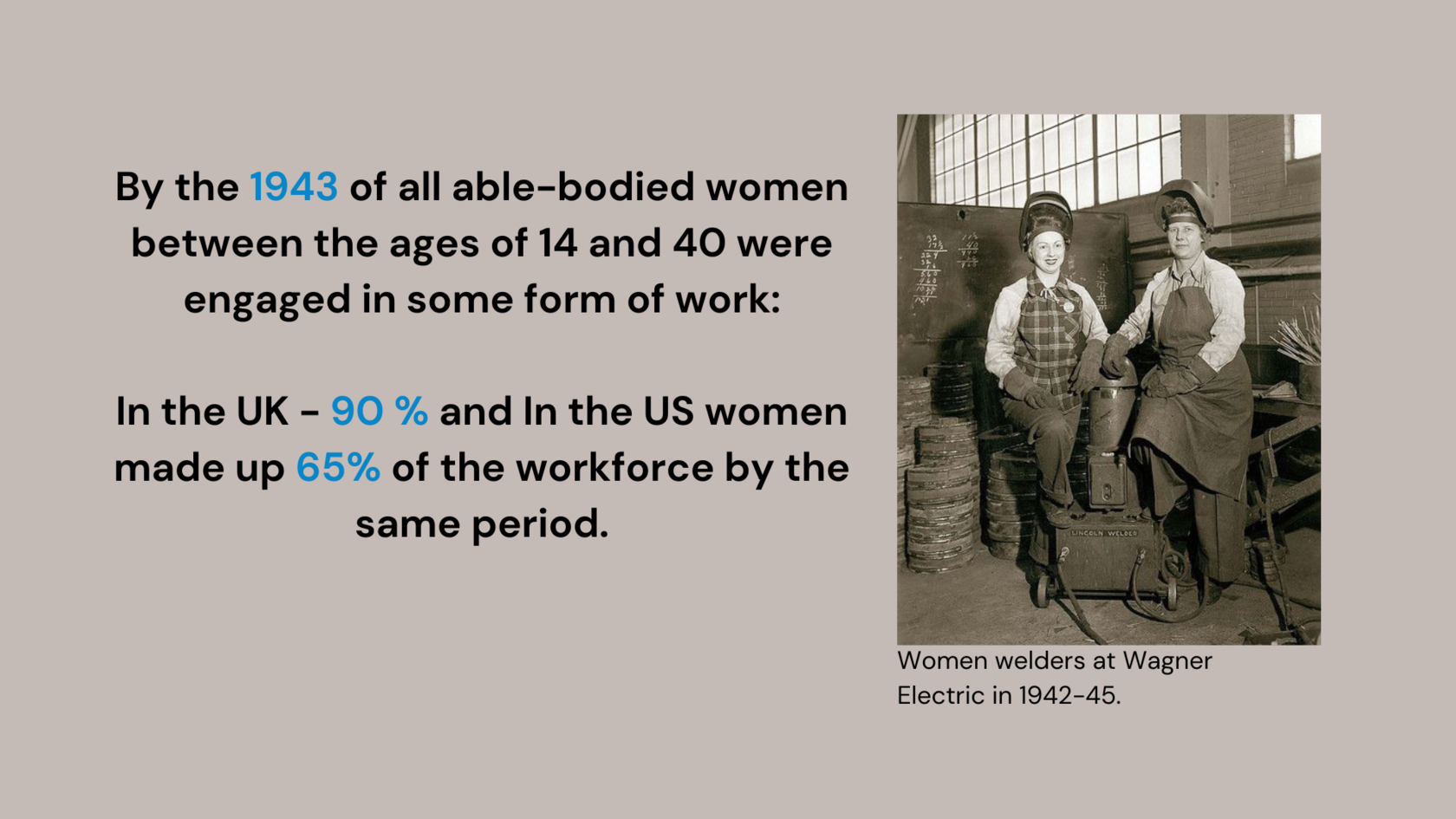
Ninety per cent of all able-bodied women between the ages of 14 and 40 were engaged in some form of work in the UK by 1943, according to government records. In the US, women made up 65% of the workforce by the same period.
Even in the face of challenges such as a lack of training, long hours, harsh winter conditions, and dangerous work environments—in addition to their pre-war duties—women worked to keep things running.
By the time the war was over, the number of employed women in the UK had gone up by more than 2 million.
So, how many females are in the welding industry today?
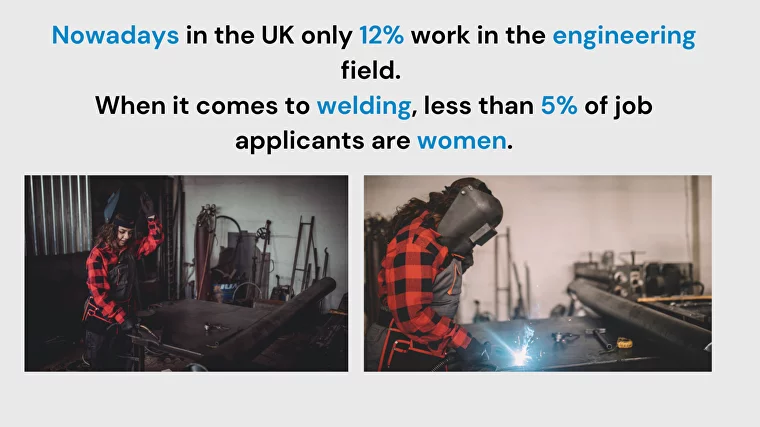
In the UK, while women make up close to half of the working population, only 12% work in the engineering field. When it comes to welding specifically, less than 5% of job applicants are women.
Opportunities for Women Who
Want to Be Welders
For women considering welding, there are opportunities to be found in sectors such as aerospace, construction, and manufacturing.
There is demand for welders, with skilled workers in the field being among those eligible for visas to address the UK’s welder shortage.
Infrastructure projects such as the Hinkley Point power station, expected to be complete in 2027, could be derailed if worker shortages persist.
Despite constituting close to half of the UK’s working population, only 12% of women are in engineering careers. However, it’s expected that by 2030, the percentage of women works in STEM fields will have risen to 30%.
What does a welding job involve?
The role of a welder involves joining, cutting and shaping metal plate, pipework and composite material. They generally work in sectors such as construction and civil engineering.

In the same breadth, there are efforts being undertaken by various institutions to improve the representation of women in welding and related fields including:
- The Welding Institute’s Women in Engineering Day event
- The creation of the Tipper Group to spur inclusive career development irrespective of gender
- The development of the Royal Academy of Engineering’s diversity and inclusion framework
- Provision of free, government-funded training by Free2Learn
- Development of the WISE (Women in Science and Engineering) 10-step initiative to help in the recruitment and retainment of women in STEM roles
Challenges Faced by Women in Welding
Even with the steps being taken to address the representation of women in welding and STEM as a whole, choosing this path comes with its challenges.
There are still many who view welding as “a man’s job.” Despite taking essential subjects such as mathematics, science, and technology, many girls don’t pursue careers in the field as they aren’t encouraged to do so. Interestingly enough, policy initiatives aimed at getting more women into STEM may have the opposite effect by signalling that it is a masculine field. On the other hand, those who pursue STEM further studies or careers may face discrimination or harassment or find themselves alienated by male counterparts who don’t consider them suited for the job.
Due to societal perceptions, women who take up roles as welders often face pressure to meet or surpass expectations in their work, making it a demanding job. As there are some who consider them out of place, female welders may be forced to meet higher standards of achievement to justify their hiring.
Is Welding a Good Career for Women?
Traditional barriers to women’s entry into welding are falling away. Here are some reasons why you might want to consider a career in welding.
Earning Potential

In the UK, welders make an average of £30,000 per year, with the highest earners making significantly more. Welders are in high demand in many sectors, so there’s the potential to earn a good living.
In the US, female welders earn an average of $40,000 annually—but this can go as high as $80,000 to $100,000.
More Job Opportunities
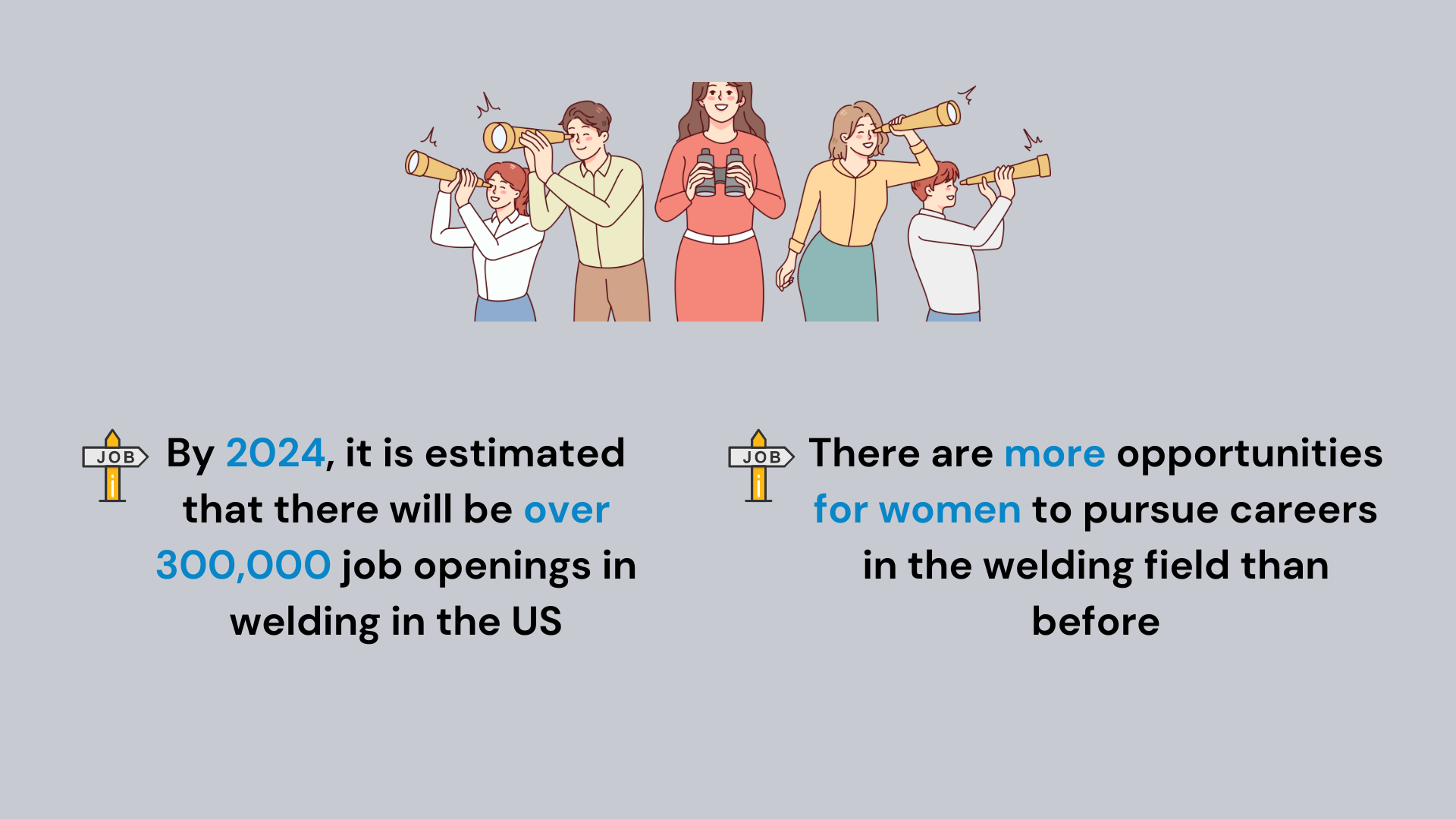
More workplaces are evaluating their structures, processes, and culture to enhance a more diverse and inclusive working environment. Consequently, there are more opportunities for women to pursue careers in the welding field than before.
By 2024, it is estimated that there will be over 300,000 job openings in welding in the US, as the existing workforce continues to retire. Moreover, the Bureau of Labor Statistics expects continued growth in the field over the next decade.
Better Physical Disposition

Women may have better hand stability than men. Results from a study on hand stability differences based on gender suggest that men have 1.3 times more total fluctuation of the hands compared to women. Steady hands are important regardless of whether you’re doing fusion or pressure welding—meaning women may be less susceptible to injuries and produce better results.
In addition, studies have shown that women typically have better balance than men. This is a plus, considering that welding calls for a significant amount of physical exertion sometimes including working at elevated levels.
Women Who Have Succeeded in Welding
In spite of the challenges, there are those who have gone into welding and have found success, some even becoming famous female welders.

Florence Collard
She worked as a welder at the Bartram and Son’s Shipyards, and she was the first woman ever to be granted membership to the Boilermaker’s Society Union.
Florence Collard was among the pioneer female welders in the UK. She was the first woman to become a member of the Boilermakers’ Society, albeit in a temporary capacity.
After her husband left for war and their Plymouth home was bombed, she moved back to her hometown. There, she joined the group of 700 women who worked at the shipyard in Sunderland, considered by locals as the biggest shipbuilding town in the world.
Due to its critical role, the town was the target of bombing attacks. Famously, after being led to safety following one such attack, Florence was so eager to get back to work that she immediately returned to her job site as though it was just an orindary day.
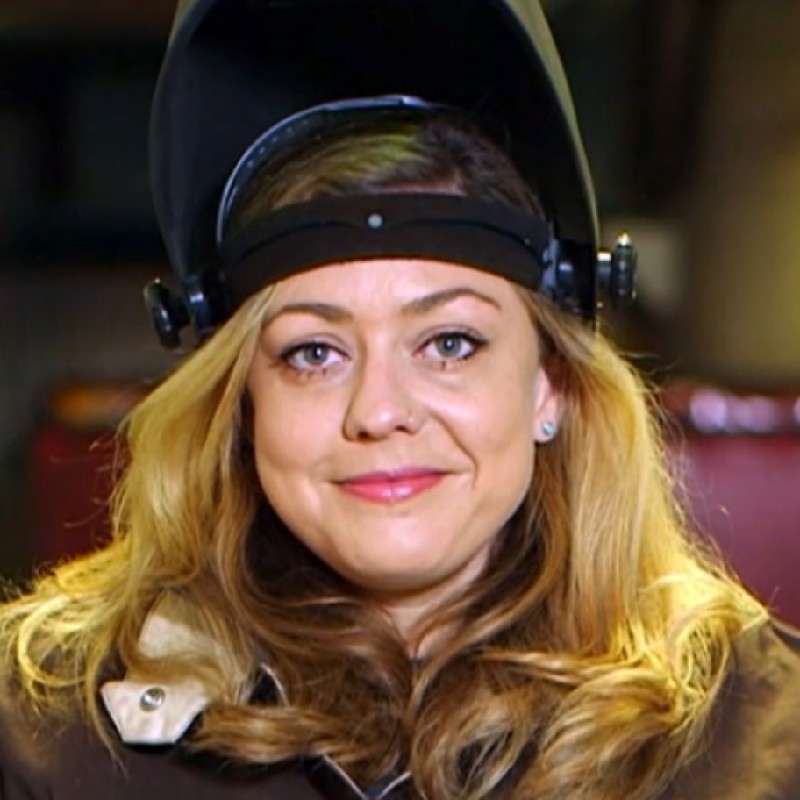
Lauren Svedman
Lauren Svedman is a former full-time welder who is now teaching other women the traditionally male trade.
She worked as a welder in the manufacturing sector following her training at the Jane Addams Resource Corporation in Chicago, IL. During her early days as a welder, she had to deal with her fair share of challenges—including the wheels of her seat being taken off and dealing with others’ unfair perceptions.
She then became a welding instructor. With close to a decade of experience in the field, Lauren now works with Chicago Women In Trades, a non-profit focused on workplace development. Graduates of her class get certified and receive assistance finding job placements.

Memesha Davis
“Working on skyscrapers that will add to the New York skyline for decades to come gives her a sense of pride” – describing how she felt helping build One Vanderbilt, a 67-floor skyscraper in midtown Manhattan.
Before she was an ironworker on track to earn six figures a year, Memesha Davis worked in retail and hospitality making minimum wage without guaranteed hours.
Her pathway into the trade was through Nontraditional Employment for Women (NEW). The New York Based organisation helps women improve their socioeconomic outcomes through training and job placement in skilled trades.
After attending classes for three years, Memesha graduated from her apprenticeship and earned certification from the American Welding Society. She has since gone on to work on projects such as the One Vanderbilt skyscraper in New York City.
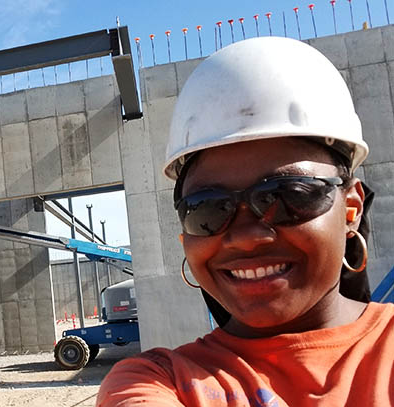
Lashanna Lintamo
“Welding, to Lintamo, has certainly been more than just a trade—or even a career. It’s been a lifestyle, a pathway for her to pursue deeper, more meaningful aspirations”
Long before she considered pursuing welding, Lashanna Lintamo’s family was involved in the trade. During the Second World War, her grandmother was among the women who took up roles in shipyards. Decades later, Lashanna would disassemble the same ships her grandmother had built and welded on the Mare Island Navy Yard.
Her grandfather, father, and uncle encouraged her to pursue a trade due to shifts in the economy and Lashanna took on a pre-apprenticeship program. The challenging nature of the work appealed to her and led her along that career path.
As a Black woman, Lashanna faced a myriad of challenges but persisted. In time, she branched into working as a freelancer and has been part of numerous projects from the Sacramento Train Station to Marriott hotels.
Getting Started as a Female Welder
To get started on your welding journey, the first step is to take a course that will equip you with the knowledge, skills, and technical expertise to excel.
It’s also important to get certified in order to meet selection criteria and demonstrate to potential employers that you are qualified for the role. One such qualification is the Construction Skills Certification Scheme (CSCS) card.
While not all welding courses offer apprenticeships, it’s a smart idea to find one, as they’re a good way to gain hands-on experience and potentially open up opportunities for further study.
Learn more about Different Types of Welding and Their Uses!
Step into a Career in Welding
There’s plenty of evidence—from more welding jobs to higher earning potential—that welding can be a great career option for women. Take the first steps toward getting into the industry for a promising career trajectory with plenty of room for growth.